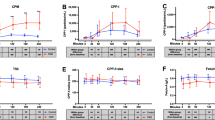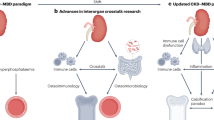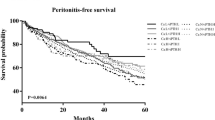Abstract
Patients with chronic kidney disease (CKD) are at increased risk of total and cardiovascular morbidity and mortality. The underlying pathophysiology of this association remains largely unexplained and there is currently no clear interventional pathway. Emphasis has been placed on measuring serum levels of calcium, phosphate and parathyroid hormone (PTH) to monitor disease progression, driven by the assumption that achieving values within the 'normal' range will translate into improved outcomes. Retrospective studies have provided a body of evidence that abnormal levels of mineral biomarkers, and phosphate in particular, are associated with clinical events. Disturbances in vitamin D metabolism are also likely to contribute to the pathophysiology of CKD. Designing studies that yield useful information has proved to be difficult, partly owing to conceptual and financial limitations, but also because of the tight interdependency of calcium, phosphate and PTH, and the potential impact of vitamin D on these mineral metabolites. An intervention that perturbs any one of these factors is likely to exert effects on the others, making isolation of the individual variables almost impossible. However, some therapies in current use have the potential to act as probes to answer questions relating to the association between mineral biomarkers and outcomes in CKD.
Key Points
-
Patients with chronic kidney disease show exceptionally high rates of total and cardiovascular morbidity and mortality, but much of the underlying pathophysiology remains unexplained
-
Abnormalities in levels of mineral metabolites and regulators, such as calcium, phosphate, parathyroid hormone, fibroblast growth factor 23 and vitamin D, have been linked to the progression of cardiovascular disease and poor outcomes
-
Phosphate has the steepest mortality dose–response relationship; a U-shaped relationship sometimes exists between levels of mineral biomarkers and outcomes, particularly for levels of parathyroid hormone
-
Although vitamin D has major interactions with mineral metabolism, no conclusive evidence exists showing that treatment with vitamin D receptor activators is beneficial for patients with chronic kidney disease
-
Current therapies, such as cinacalcet and phosphate binders, could be used to probe the relationship between various mineral biomarkers as well as to assess their contribution to disease
-
Future trial design should consider the possibility of comparing two or more levels of therapy, which could yield important information about appropriate target ranges
This is a preview of subscription content, access via your institution
Access options
Subscribe to this journal
Receive 12 print issues and online access
$189.00 per year
only $15.75 per issue
Buy this article
- Purchase on SpringerLink
- Instant access to full article PDF
Prices may be subject to local taxes which are calculated during checkout
Similar content being viewed by others
References
Lindner, A., Charra, B., Sherrard, D. J. & Scribner, B. H. Accelerated atherosclerosis in prolonged maintenance hemodialysis. N. Engl. J. Med. 290, 697–701 (1974).
Go, A. S., Chertow, G. M., Fan, D., McCulloch, C. E. & Hsu, C. Y. Chronic kidney disease and the risks of death, cardiovascular events, and hospitalization. N. Engl. J. Med. 351, 1296–1305 (2004).
Collins, A. J., Foley, R. N., Gilbertson, D. T. & Chen, S. C. The state of chronic kidney disease, ESRD, and morbidity and mortality in the first year of dialysis. Clin. J. Am. Soc. Nephrol. 4 (Suppl. 1), S5–S11 (2009).
Goldsmith, D. Extraordinary popular delusions and the madness of crowds: puncturing the epoetin bubble—lessons for the future. Nephrol. Dial. Transplant. 26, 24–28 (2011).
National Kidney Foundation. K/DOQI clinical practice guidelines for bone metabolism and disease in chronic kidney disease. Am. J. Kidney Dis. 42 (Suppl. 3), S1–S201 (2003).
Goldsmith, D., Ritz, E. & Covic, A. Vascular calcification: a stiff challenge for the nephrologist: does preventing bone disease cause arterial disease? Kidney Int. 66, 1315–1333 (2004).
Haydar, A. A., Covic, A., Colhoun, H., Rubens, M. & Goldsmith, D. J. Coronary artery calcification and aortic pulse wave velocity in chronic kidney disease patients. Kidney Int. 65, 1790–1794 (2004).
Moe, S. et al. Definition, evaluation, and classification of renal osteodystrophy: a position statement from Kidney Disease: Improving Global Outcomes (KDIGO). Kidney Int. 69, 1945–1953 (2006).
Kidney Disease: Improving Global Outcomes (KDIGO) CKD-MBD Work Group. KDIGO clinical practice guideline for the diagnosis, evaluation, prevention, and treatment of chronic kidney disease-mineral and bone disorder (CKD-MBD). Kidney Int. Suppl. 113, S1–S130 (2009).
Kanbay, M., Goldsmith, D., Akcay, A. & Covic, A. Phosphate—the silent stealthy cardiorenal culprit in all stages of chronic kidney disease: a systematic review. Blood Purif. 27, 220–230 (2009).
Goldsmith, D. et al. Systematic review of the evidence underlying the association between mineral metabolism disturbances and risk of fracture and need for parathyroidectomy in CKD. Am. J. Kidney Dis. 53, 1002–1013 (2009).
Covic, A. et al. Systematic review of the evidence underlying the association between mineral metabolism disturbances and risk of all-cause mortality, cardiovascular mortality and cardiovascular events in chronic kidney disease. Nephrol. Dial. Transplant. 24, 1506–1523 (2009).
Covic, A. et al. Vascular calcification in chronic kidney disease. Clin. Sci. (Lond.) 119, 111–121 (2010).
Stevens, L. A., Djurdjev, O., Cardew, S., Cameron, E. C. & Levin, A. Calcium, phosphate, and parathyroid hormone levels in combination and as a function of dialysis duration predict mortality: evidence for the complexity of the association between mineral metabolism and outcomes. J. Am. Soc. Nephrol. 15, 770–779 (2004).
Kovesdy, C. P., Ahmadzadeh, S., Anderson, J. E. & Kalantar-Zadeh, K. Association of activated vitamin D treatment and mortality in chronic kidney disease. Arch. Intern. Med. 168, 397–403 (2008).
Palmer, S. C. et al. Serum levels of phosphorus, parathyroid hormone, and calcium and risks of death and cardiovascular disease in individuals with chronic kidney disease: a systematic review and meta-analysis. JAMA 305, 1119–1127 (2011).
Goodman, W. G. et al. Coronary-artery calcification in young adults with end-stage renal disease who are undergoing dialysis. N. Engl. J. Med. 342, 1478–1483 (2000).
Block, G. A. et al. Mineral metabolism, mortality, and morbidity in maintenance hemodialysis. J. Am. Soc. Nephrol. 15, 2208–2218 (2004).
Floege, J. et al. for the ARO Investigators. Serum iPTH, calcium and phosphate, and the risk of mortality in a European haemodialysis population. Nephrol. Dial. Transplant. doi: 10.1093/ndt/gfq219.
Tentori, F. Mineral and bone disorder and outcomes in hemodialysis patients: results from the DOPPS. Semin. Dial. 23, 10–14 (2010).
Kovesdy, C. P., Anderson, J. E. & Kalantar-Zadeh, K. Outcomes associated with serum phosphorus level in males with non-dialysis dependent chronic kidney disease. Clin. Nephrol. 73, 268–275 (2010).
Bolland, M. J. et al. Effect of calcium supplements on risk of myocardial infarction and cardiovascular events: meta-analysis. BMJ 341, c3691 (2010).
Holick, M. F. Vitamin D deficiency. N. Engl. J. Med. 357, 266–281 (2007).
Holick, M. F. Vitamin D: evolutionary, physiological and health perspectives. Curr. Drug Targets 12, 4–18 (2011).
Seiler, S., Heine, G. H. & Fliser, D. Clinical relevance of FGF-23 in chronic kidney disease. Kidney Int. Suppl. 114, S34–S42 (2009).
Shroff, R., Knott, C. & Rees, L. The virtues of vitamin D—but how much is too much? Pediatr. Nephrol. 25, 1607–1620 (2010).
Wolf, M. et al. Impact of activated vitamin D and race on survival among hemodialysis patients. J. Am. Soc. Nephrol. 19, 1379–1388 (2008).
Teng, M. et al. Activated injectable vitamin D and hemodialysis survival: a historical cohort study. J. Am. Soc. Nephrol. 16, 1115–1125 (2005).
Teng, M. et al. Survival of patients undergoing hemodialysis with paricalcitol or calcitriol therapy. N. Engl. J. Med. 349, 446–456 (2003).
Tentori, F. et al. The survival advantage for haemodialysis patients taking vitamin D is questioned: findings from the Dialysis Outcomes and Practice Patterns Study. Nephrol. Dial. Transplant. 24, 963–972 (2009).
Tentori, F. et al. Mortality risk among hemodialysis patients receiving different vitamin D analogs. Kidney Int. 70, 1858–1865 (2006).
de Zeeuw, D. et al. Selective vitamin D receptor activation with paricalcitol for reduction of albuminuria in patients with type 2 diabetes (VITAL study): a randomised controlled trial. Lancet 376, 1543–1551 (2010).
Covic, A., Gusbeth-Tatomir, P. & Goldsmith, D. Negative outcome studies in end-stage renal disease: how dark are the storm clouds? Nephrol. Dial. Transplant. 23, 56–61 (2008).
Isakova, T., Gutiérrez, O. M. & Wolf, M. A blueprint for randomized trials targeting phosphorus metabolism in chronic kidney disease. Kidney Int. 76, 705–716 (2009).
Block, G. A. et al. Cinacalcet for secondary hyperparathyroidism in patients receiving hemodialysis. N. Engl. J. Med. 350, 1516–1525 (2004).
Brown, E. M. Clinical utility of calcimimetics targeting the extracellular calcium-sensing receptor (CaSR). Biochem. Pharmacol. 80, 297–307 (2010).
Cunningham, J., Danese, M., Olson, K., Klassen, P. & Chertow, G. M. Effects of the calcimimetic cinacalcet HCl on cardiovascular disease, fracture, and health-related quality of life in secondary hyperparathyroidism. Kidney Int. 68, 1793–1800 (2005).
Block, G. A. et al. Cinacalcet hydrochloride treatment significantly improves all-cause and cardiovascular survival in a large cohort of hemodialysis patients. Kidney Int. 78, 578–589 (2010).
Chertow, G. M. et al. Evaluation of Cinacalcet Therapy to Lower Cardiovascular Events (EVOLVE): rationale and design overview. Clin. J. Am. Soc. Nephrol. 2, 898–905 (2007).
Goldsmith, D. & Covic, A. Time to Reconsider Evidence for Anaemia Treatment (TREAT) = Essential Safety Arguments (ESA). Nephrol. Dial. Transplant. 25, 1734–1737 (2010).
Chertow, G. M. et al. Cinacalcet hydrochloride (Sensipar) in hemodialysis patients on active vitamin D derivatives with controlled PTH and elevated calcium x phosphate. Clin. J. Am. Soc. Nephrol. 1, 305–312 (2006).
Levin, A. et al. Prevalence of abnormal serum vitamin D, PTH, calcium, and phosphorus in patients with chronic kidney disease: results of the study to evaluate early kidney disease. Kidney Int. 71, 31–38 (2007).
Gutiérrez, O. M. et al. Fibroblast growth factor 23 and mortality among patients undergoing hemodialysis. N. Engl. J. Med. 359, 584–592 (2008).
Mirza, M. A., Larsson, A., Melhus, H., Lind, L. & Larsson, T. E. Serum intact FGF23 associate with left ventricular mass, hypertrophy and geometry in an elderly population. Atherosclerosis 207, 546–551 (2009).
Kanbay, M. et al. Fibroblast growth factor 23 and fetuin A are independent predictors for the coronary artery disease extent in mild chronic kidney disease. Clin. J. Am. Soc. Nephrol. 5, 1780–1786 (2010).
Jüppner, H., Wolf, M. & Salusky, I. B. FGF-23: more than a regulator of renal phosphate handling? J. Bone Miner. Res. 25, 2091–2097 (2010).
Isakova, T. et al. Pilot study of dietary phosphorus restriction and phosphorus binders to target fibroblast growth factor 23 in patients with chronic kidney disease. Nephrol. Dial. Transplant. 26, 584–591 (2011).
Kalantar-Zadeh, K. et al. Kidney bone disease and mortality in CKD: revisiting the role of vitamin D, calcimimetics, alkaline phosphatase, and minerals. Kidney Int. Suppl. 117, S10–S21 (2010).
Acknowledgements
C. P. Vega, University of California, Irvine, CA, is the author of and is solely responsible for the content of the learning objectives, questions and answers of the Medscape, LLC-accredited continuing medical education activity associated with this article.
Author information
Authors and Affiliations
Contributions
D. J. A. Goldsmith and J. Cunningham contributed equally to discussion of content for the article, and to writing, editing and reviewing of the manuscript before submission.
Corresponding author
Ethics declarations
Competing interests
D. J. A. Goldsmith has received honoraria/fees from Amgen, Fresenius, Genzyme, Novartis, and Shire. J. Cunningham has received research support from Abbott and Amgen, and honoraria/fees from Amgen, Cytochroma, Fresenius, Genzyme, Leo Pharma, Novartis, and Shire.
Rights and permissions
About this article
Cite this article
Goldsmith, D., Cunningham, J. Mineral metabolism and vitamin D in chronic kidney disease—more questions than answers. Nat Rev Nephrol 7, 341–346 (2011). https://doi.org/10.1038/nrneph.2011.53
Published:
Issue date:
DOI: https://doi.org/10.1038/nrneph.2011.53
This article is cited by
-
Vitamin D in patients with chronic kidney disease: a position statement of the Working Group “Trace Elements and Mineral Metabolism” of the Italian Society of Nephrology
Journal of Nephrology (2016)
-
FGF-23 levels in patients with critical carotid artery stenosis
Internal and Emergency Medicine (2015)
-
Higher fibroblast growth factor-23 increases the risk of all-cause and cardiovascular mortality in the community
Kidney International (2013)
-
Clinical Features and Manifestations of CKD-MBD
Clinical Reviews in Bone and Mineral Metabolism (2012)
-
Biochemical Abnormalities in Chronic Kidney Disease–Mineral Bone Disease
Clinical Reviews in Bone and Mineral Metabolism (2012)



